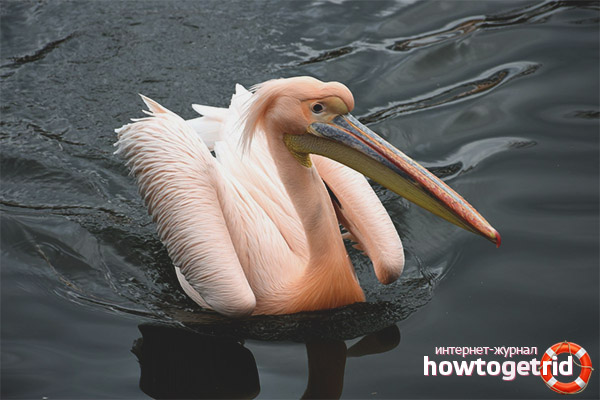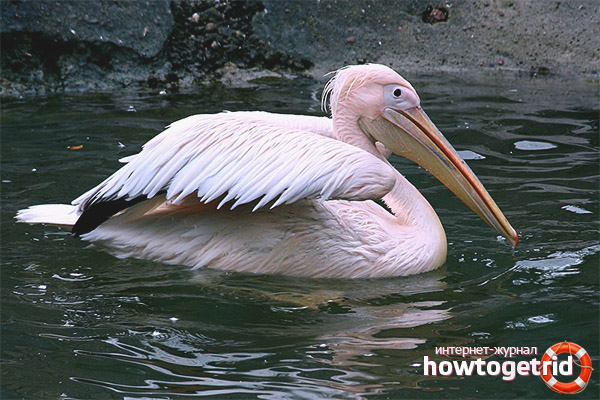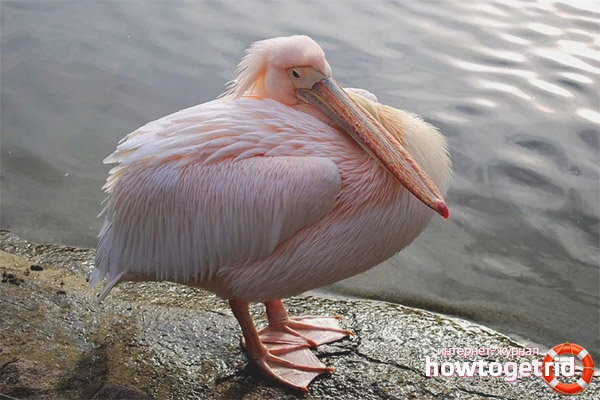The content of the article
The pink pelican is one of 8 species of birds of the pelican-like family. It has a fairly large size, approximately like a swan. In its family, it is the second largest after a curly pelican.
Appearance
The male of this bird is larger than the female. As a rule, the weight of the male reaches 11 kg, and the female - 10 kg. The wing length of a female individual is 64-69 cm, male - from 70-75 cm. The wingspan of the pelican is 3-3.6 meters, and the body length is 1.75 m. The beak, like its relatives, is long and straight, with a bag characteristic of the pelican, which is very stretched.
The bird’s neck is very long, but the legs on the contrary are short. Around the eyes, nose bridge, on the forehead and lower jaw, delicate yellow skin without any feathers. On the head is a small forelock of long pointed feathers.
In adults, the plumage is painted white, with a pink tint, which intensifies to the abdominal part. It is thanks to the plumage that the bird got its name. There is a buffy spot on the chest. Through the yellowish bag on the beak, one can see blood vessels of bright red color. The beak of the female is 30-45 cm, the male is 35-47 cm; with it, individuals breathe because they do not have nostrils.
The upper beak is bluish-gray in color, a white hook on top with a pink trim dotted with red spots. The mandible part with the base of a bluish tint smoothly passes to the top of the yellow color. Feet webbed, yellow with an orange tint on the bends. The bird’s iris is pale red.
The young have a head with a transition to the grayish neck. Closer to the back, the hue becomes lighter, the dorsal part itself is pale blue. The feathers of the feathers are brown-black, secondary with a slight silver coating, on the main feathers there is a white border.
A pelican flies majestically, rarely, but flapping its wings strongly, soaring slowly in the air. In flight, overturns the head, thus supporting a heavy beak. Large wings help to hold the largest bird, the heaviest of all flying.
In the mating season, bloating forms on the non-caked part of the forehead. And other non-feathered parts of the skin turn saturated red with a slight shade of yellow. The iris of the eye is poured to a dark red color. Neck bag in ocher color. Pelicans' sex differences are poorly developed; the main difference between individuals is size.
The skeleton of a bird weighs 1/10 of the total body weight. Sacks of air are located throughout his body - under the wings, on the throat and chest in the interosseous space. Thanks to this, they plan so easily in the air and cannot dive.
Bird habitat
Pink pelicans are listed in the Red Book as an endangered species. These birds nest in Southwest Asia, Africa and Southwest Europe. The main part of the nesting stretches from Europe to Mongolia. At the hibernation, the main part flies to Africa, and some to the south of Asia. At the beginning of the last century, the main habitats were the Czech Republic, Ukraine, Moldova and Hungary.
In Russia, the pelican habitat is the channel of the Volga River, southeast of the Sea of Azov. In Asia, the Aral Sea, the Syr Darya delta and the adjacent lakes. In Iran - Lake Umria, Mesopotamia, Northwest India and Syria.
Resident populations inhabit Lake Nyasa in Africa to Senegal.In addition to Africa, the permanent residence of this species is the south of Vietnam and the western part of India.
Bird nutrition and lifestyle
Basically, a swimming pelican eats medium-sized fish. Goes into shallow water, opens the beak, while stretching the throat sac, scoops up fish with water. He flushes the water and then swallows the prey, it is noteworthy that in the neck bag it can hold up to 3 medium buckets of fish.
It is extremely rare for different species of birds to get food together, the pink pelican is one of these species. When they get food, the birds form a circle, flap their wings on the water, mackle up, driving the fish into a circle, and after that they simultaneously scoop it up. A pelican cannot dive, therefore it only lowers its head and neck into the water.
In Europe, carps make up the diet of birds, while cyclites are mined in Africa. As a rule, most of the food is large and medium sized fish. Daily requirement - 1-1.2 kg of fish.
They lead the most active way of life in the morning and in the evening, it is hot in the afternoon and they prefer to sit out. A whole flock of birds swing on the waves, hunt and sleep. There are times when a bird fights off a colony, which means that it is wounded or sick. The colonial way of life is explained by the instincts of protection, it is easier to fight off attacks by predators. However, there is no hierarchical ladder in the flock; all birds occupy an equal position.
This species does not belong to the aggressive, they do not enter into a struggle with each other. The only cause of fights may be a fight for the nest, in such a battle they are capable of inflicting serious wounds on the enemy with their powerful beak.
Reproduction of the species
Pelicans are monogamous species and create strong pairs. Sexual development occurs at 3 years old, at the same time, the bird receives the plumage of an adult. Arriving at the nesting flock, they are immediately distributed in pairs, and after that they are beaten off by fellow tribesmen for the duration of mating. At the time of mating games, birds jump, take off, spread their wings and rub their beaks.
Nests are built in the shallow waters of lakes and rivers. Couples nest in whole flocks, in close proximity to each other, sometimes closely adjacent to shelters. The female is engaged in the construction of the dwelling, while the male provides it with all the necessary materials - grass, branches, clay, and brings them to the place of the future nest. 2 days with a little respite. Once the place is ready, mate.
Settled birds are able to incubate eggs at any time of the year, and migratory birds, as a rule, breed in the spring.
Since pelicans nest in colonies of 10-50 individuals, the chicks hatch almost simultaneously. Hatching pelicans are blind, with skin of a pale pink hue without feathers. In the coming hours, each chick changes color to gray and dark brown. A week later, the skin is covered with down.
In the first 5 days of the chick's life, the parents belch out half-digested food in their beak, and only then they feed it with fish. After 1.5 months, the young flies out of the nest.
In the wild, the pelican lives from 15-25 years, in captivity, life expectancy can reach up to 30 years.
Video: Pink Pelican (Pelecanus onocrotalus)












Submit